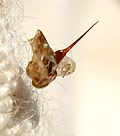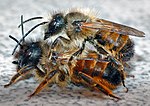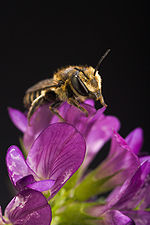Diseases of the honey bee or abnormal hive conditions include: Varroa destructor and V. jacobsoni are parasitic mites that feed on the fat bodies of adult...
67 KB (7,708 words) - 07:29, 20 May 2024
The western honey bee or European honey bee (Apis mellifera) is the most common of the 7–12 species of honey bees worldwide. The genus name Apis is Latin...
95 KB (11,411 words) - 02:55, 26 August 2024
The Africanized bee, also known as the Africanized honey bee (AHB) and colloquially as the "killer bee", is a hybrid of the western honey bee (Apis mellifera)...
56 KB (6,412 words) - 22:00, 21 August 2024
The following are lists of animal diseases: List of aquarium diseases List of dog diseases List of feline diseases List of diseases of the honey bee List...
606 bytes (67 words) - 11:28, 2 February 2024
than honey bees, particularly the European honey bee (Apis mellifera). Worker bees of this variety are responsible for approximately 80% of the world's...
21 KB (2,597 words) - 14:04, 6 July 2024
is the Italian bee or the Italian Honey bee which is a subspecies of the western honey bee (Apis mellifera). The Italian honey bee is endemic to the continental...
12 KB (1,516 words) - 03:57, 18 July 2024
Beekeeping (redirect from Bee-keeping)
is the maintenance of bee colonies, commonly in artificial beehives. Honey bees in the genus Apis are the most commonly kept species but other honey producing...
89 KB (9,894 words) - 08:58, 19 August 2024
honey bee (also spelled honeybee) is a eusocial flying insect within the genus Apis of the bee clade, all native to mainland Afro-Eurasia. After bees...
99 KB (11,700 words) - 07:04, 28 August 2024
components. A honey bee that is away from the hive foraging for nectar or pollen will rarely sting, except when stepped on or roughly handled. Honey bees will...
14 KB (1,582 words) - 19:43, 29 June 2024
Honey is a sweet and viscous substance made by several species of bees, the best-known of which are honey bees. Honey is made and stored to nourish bee...
123 KB (13,317 words) - 03:52, 12 August 2024
the best-known bee species, the western honey bee, for producing honey. Bees are a monophyletic lineage within the superfamily Apoidea. They are currently...
119 KB (12,322 words) - 11:34, 27 August 2024
Mason bee is a name now commonly used for species of bees in the genus Osmia, of the family Megachilidae. Mason bees are named for their habit of using...
14 KB (1,639 words) - 01:20, 24 August 2023
The Apis mellifera mellifera (commonly known as the European dark bee) is a subspecies of the western honey bee, evolving in central Asia, with a proposed...
49 KB (5,696 words) - 23:04, 4 April 2024
'honey-eater'). Colony collapse disorder Honey bee starvation Pesticide toxicity to bees Diseases of the honey bee Pollinator decline List of honey plants...
35 KB (3,861 words) - 20:02, 21 August 2024
The Buckfast bee is a breed of honey bee, a cross of many subspecies and their strains, developed by Brother Adam (born Karl Kehrle in 1898 in Germany)...
20 KB (2,620 words) - 01:50, 26 May 2024
Apitherapy (redirect from Honey for multiple sclerosis)
Apitherapy is a branch of alternative medicine that uses honey bee products, including honey, pollen, propolis, royal jelly and bee venom. There has been...
11 KB (1,162 words) - 10:25, 3 August 2024
Nosema apis (category Western honey bee pests)
affects honey bees. It causes nosemosis, also called nosema, which is the most common and widespread of adult honey bee diseases. The dormant stage of N. apis...
19 KB (2,288 words) - 22:52, 10 January 2024
Honeybee starvation (redirect from Honey bee starvation)
Honey bee starvation is a problem for bees and beekeepers. Starvation may be caused by unfavorable weather, disease, long distance transportation or depleting...
13 KB (1,592 words) - 11:18, 13 January 2024
Apis andreniformis (redirect from Black dwarf honey bee)
andreniformis, or the black dwarf honey bee, is a relatively rare species of honey bee whose native habitat is the tropical and subtropical regions of Southeast...
18 KB (2,266 words) - 20:30, 13 January 2024
and bee venom. Bee – a member of the order that includes ants and wasps Bee anatomy (mouth) Bee bread – the main source of food for most honey bees and...
4 KB (491 words) - 14:19, 5 September 2023
The honey badger (Mellivora capensis), also known as the ratel (/ˈrɑːtəl/ or /ˈreɪtəl/), is a mammal widely distributed in Africa, Southwest Asia, and...
30 KB (2,972 words) - 06:06, 30 March 2024
Oriental hornet (category CS1 maint: multiple names: authors list)
transmitter of disease following consumption of infected plants. The hornets are a primary pest to honey bees, attacking bee colonies to obtain honey and animal...
25 KB (2,796 words) - 16:40, 5 June 2024
The California carpenter bee or Western carpenter bee, Xylocopa californica, is a species of carpenter bee in the order Hymenoptera, and it is native...
12 KB (1,411 words) - 21:05, 2 August 2024
Deformed wing virus (category Western honey bee pests)
one of 22 known viruses affecting honey bees. While most commonly infecting the honey bee, Apis mellifera, it has also been documented in other bee species...
14 KB (1,904 words) - 12:12, 7 August 2024
Apis mellifera iberiensis (category Western honey bee breeds)
mellifera iberiensis, or the Spanish bee, is a western honey bee subspecies native to the Iberian Peninsula. It is also found on the Balearic Islands. This...
11 KB (1,290 words) - 16:15, 2 July 2023
Megachile rotundata (redirect from Alfalfa leafcutter bee)
half as painful as a honey bee's. Megachile rotundata is a member of the subfamily Megachilinae, which includes more than 4,000 bee species; this currently...
30 KB (3,626 words) - 15:45, 22 August 2024
Within biological taxonomy, a honey bee race would be an informal rank in the taxonomic hierarchy, below the level of subspecies. It has been used as...
9 KB (984 words) - 05:35, 23 September 2023
knowledgeable management of pollenizers, pollinators, and pollination conditions. While people think first of the European honey bee when pollination comes...
15 KB (1,490 words) - 07:59, 8 December 2023





















